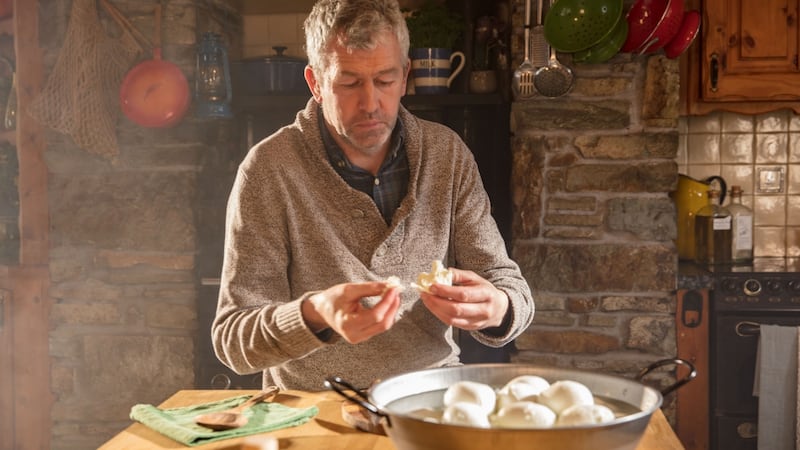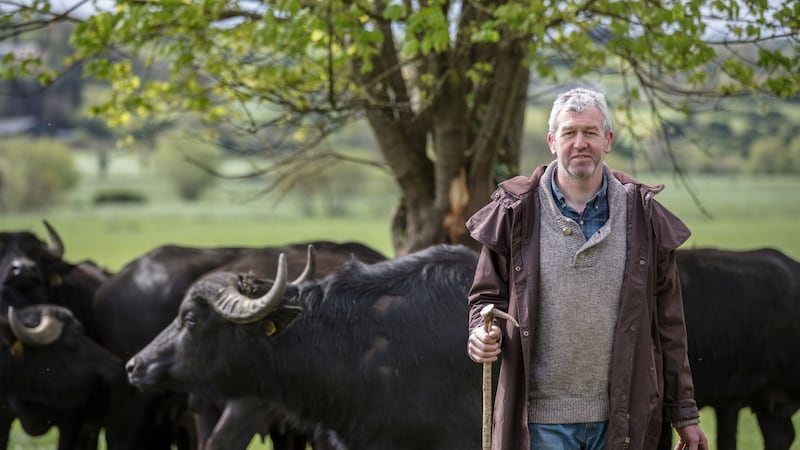When Johnny Lynch decided to replace his herd of dairy cows in 2009 with 31 water buffalo calves that he found for sale on a farm in Italy, his neighbours thought he was mad. His friends thought he was mad. The authorities thought he was mad.
"They all laughed at me," he recalls as he stands outside his small but perfectly formed buffalo mozzarella cheese-making plant a couple of kilometres outside Macroom, Co Cork.
"The local farmers just said: 'No good, no good.' To be honest, I think they sort of felt sorry for me. I know there was an awful lot of jokes made at my expense. And I remember going to Teagasc looking for advice before I started. They just told me not to do it."
But Johnny knew what he was doing. Sort of. He had watched the farm gate price for his cows’ milk tumble and knew it would tumble faster once EU milk quotas disappeared in 2015. “The farm was nowhere near big enough to make a living in dairy so we had to do something else,” he says.
Buffalo are much brainier than cows. After a week in the milking parlour, the herd had worked out exactly how to open the gates keeping them in
The something else was buffalo farming. Initially his plan was to source a milking herd in the UK but there was a hitch with the transaction and he ended up travelling to Italy instead. He found some calves he liked the look of but did not like the look of the bill as Italian buffalo come with a significant premium attached.
It turns out that the premium saved him a lot of heartache and a lot of money. The first Buffalo herd he had his eye – the one coming from the UK – had a lineage stretching all the way back to Romania. The calves looked good but Lynch subsequently found out they "don't tend to be great milk producers" and farmers who bought the stock he nearly bought have had terrible problems with second and third generations of the stock.
His Italian buffalo, on the other hand, were and still are excellent milk producers and the 80,000 tonnes of cheese he has sold through Aldi since he went into business with the retailer in 2015 is proof of that fact.
Thick hides
In 2010 they arrived and took to west Cork instantly – as well they might because, despite the fact that buffalo are most commonly found in sun-kissed spots such as southern Italy, they don't actually like the heat because their hides are around eight times thicker than a cow's and they struggle with the whole business of heat regulation. That is why they like nothing more than a good wallow in cold water. And if there's one thing we have plenty of in Ireland, it's cold water.
It took a year or so before the new arrivals were ready for milking but by 2011 things were falling into place. Then things started to fall apart.
Lynch’s animals were producing good quantities of milk for a local mozzarella maker and all was well until he was given news that saw almost everything else in his world fade into insignificance. He was diagnosed with bowel cancer.

“It was a pretty tough time to be honest,” he says matter-of-factly. “We lost money for four years straight and then there was the cancer. I’m convinced it was brought on by all the stress. Knowing what I know now, I’m not sure I’d do it all again. It was a very tough time.” His tone makes it clear he is not looking for sympathy, he’s just telling it as it is – or was.
Fast-forward to today and Lynch is in a very different place. He looks the picture of health and his cheese-making business is finally making money allowing him to work on plans to grow his novel enterprise.
Aldi and Lilliput
He split from his cheese-making business partner and set out on his own. In 2015 he secured a major contract to supply buffalo mozzarella to Aldi and he sells his cheese into the other big supermarkets around the State under his own brand name – Macroom Mozzarella. It is also being sold into the high-end restaurant trade through Lilliput Stores.
“Without Aldi we wouldn’t be here, it is as simple as that,” he says. “We started selling to them in April 2015 and it completely transformed our business.”
His herd has grown through a controlled breeding programme using the farm’s own buffalo bulls as well as artificial insemination to prevent inbreeding and now he has about 280 milking buffalo with a further 10 in calf.
All told more than 120 calves will be born in Cork this year with more again likely to come into the world next year. Lynch wants to grow his heard by 20 per cent year on year for the next three years. The only thing that will stop him expanding is land.
As we walk through the farm he points to a calf. It is less than a day old and ridiculously cute. It will grow up to be ridiculously smart, Lynch says. “Buffalo are much brainier than cows. After a week in the milking parlour, the herd had worked out exactly how to open the gates keeping them in. So I changed the locking mechanism and they worked out how to open that too. A cow would never have worked that out.”
The animals produce as much as 10 litres of milk each day and the milk is higher in both protein and fat and considerably lower in the bad kind of cholesterol than regular milk. It is particularly attractive to people with cow’s milk allergies and actually tastes virtually identical.

“We have people calling in all the time looking for the milk,” Lynch says. “I’ve have to say no a lot – we just don’t have enough. We are the only milking herd in Ireland and if we don’t have enough milk for the cheese there won’t be any cheese. It is that simple. It’s not like we can borrow supplies from the next door neighbour if we run out.”
And if Lynch has no cheese he has no business. Today his farm makes four types of buffalo milk cheese – mozzarella, a Greek haloumi style, a feta style, and a ricotta.
Hard cheese
All the varieties are made by Seán Ferry, a man blessed among the cheese makers of Ireland. Before he started making mozzarella in Macroom he made hard cheese for some of the most famous makers in Ireland.
While the hard cheeses of his past took time, Ferry’s world goes at a much faster pace now and the mozzarella he makes on a Monday can be on supermarket shelves by Wednesday.
As he talks through the process he makes it all sound very simple. Rennet is added to the milk which causes it to coagulate and the curd separate from the whey and once the pH level reaches a precise point – 4.8 – the soon-to-be cheese becomes as stretchy as chewing gum. It is put in a small but vigorous stretching machine and softened by hot water before being poured into a moulding machine which shapes the goo into the familiar balls.
It is then transferred into a tank of brine, then another tank of slightly less briney water and then into bags and shipped out to shops. Once the milk leaves the buffalo, it can be cheese within eight hours. The plant is small but still processes 2,000 balls of mozzarella a day. It has won multiple awards and its reputation is growing and spreading. Even the Italians, who are very precious about their mozzarella have given it the thumbs-up. “We’d a group over to look at our operation,” Lynch says. “They couldn’t believe it was so good. They thought no one could compete with them.”
Goth theory
The Italians claim ownership of buffalo mozzarella – mostly notably those in the Campania region but buffalo are a relatively recently arrival there too – although just how they ended up in the hottest part of the Italian boot is hard to say. Some stories say the Goths brought them in as the Roman Empire crumbled. Then an outbreak of malaria saw the Goths and the locals flee the area where the buffalo had been brought. Centuries later, people returned to find it had become, in their absence, the region where the buffalo roamed – tens of thousands of them.
Another less exotic theory would have it that Normans brought buffalo to the mainland from Sicily where they had been left by Arab settlers while a third notion suggests Arabs brought buffalo into Mesopotamia and crusaders brought them to Italy after the Holy Wars. The dullest theory – one proposed by archaeologists – says fossil evidence proves buffalo originated in Italy.
But back to Lynch, he must eat it a lot of his own product. Does he like it? “Would you believe I used to hate cheese? But then I started doing this so I had to eat it for quality control purposes. I used to eat a lot of it. Now I might eat it a couple of times a month. I eat it like an apple. I know other people cut the cheese into slices and serve it with tomato and basil but as I’m just testing it for flavour and texture, I eat it like an apple. The milk is flying down my face and going all over me. It can get very messy to be honest.”
Given the quality of the end product, the mess is worth it.










